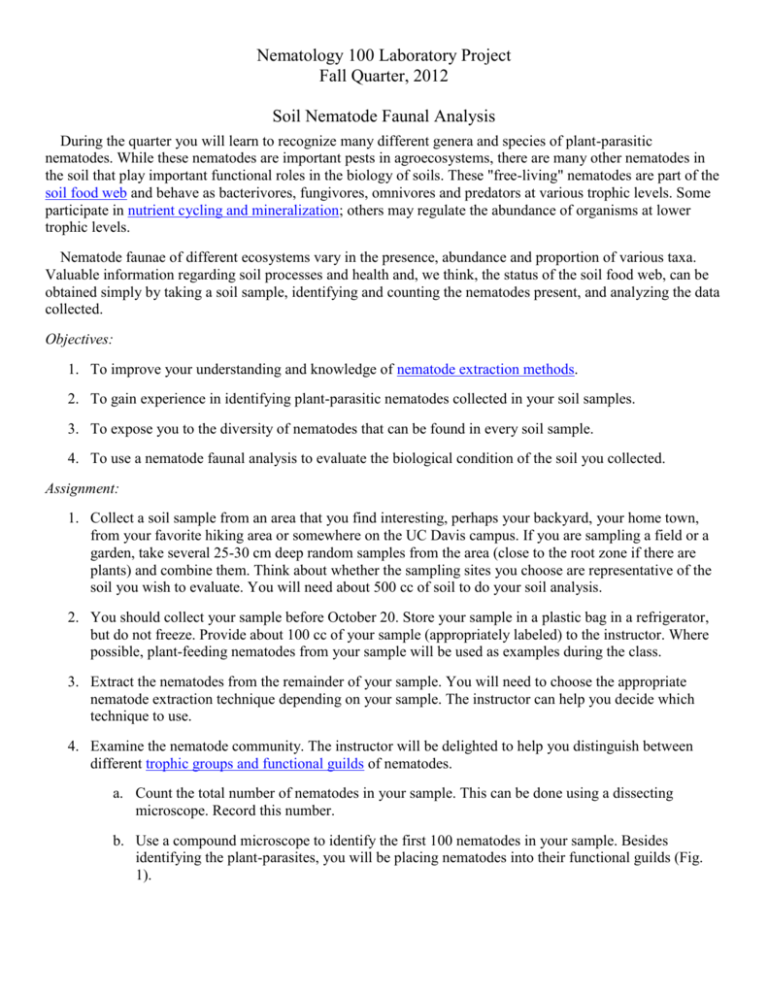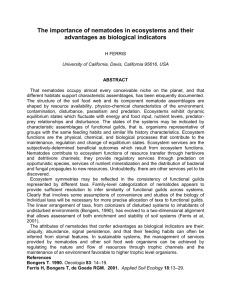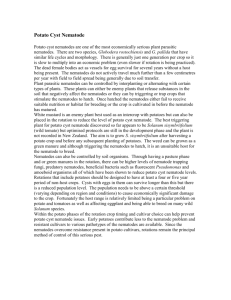Lab Project Exercise - the University of California, Davis
advertisement

Nematology 100 Laboratory Project Fall Quarter, 2012 Soil Nematode Faunal Analysis During the quarter you will learn to recognize many different genera and species of plant-parasitic nematodes. While these nematodes are important pests in agroecosystems, there are many other nematodes in the soil that play important functional roles in the biology of soils. These "free-living" nematodes are part of the soil food web and behave as bacterivores, fungivores, omnivores and predators at various trophic levels. Some participate in nutrient cycling and mineralization; others may regulate the abundance of organisms at lower trophic levels. Nematode faunae of different ecosystems vary in the presence, abundance and proportion of various taxa. Valuable information regarding soil processes and health and, we think, the status of the soil food web, can be obtained simply by taking a soil sample, identifying and counting the nematodes present, and analyzing the data collected. Objectives: 1. To improve your understanding and knowledge of nematode extraction methods. 2. To gain experience in identifying plant-parasitic nematodes collected in your soil samples. 3. To expose you to the diversity of nematodes that can be found in every soil sample. 4. To use a nematode faunal analysis to evaluate the biological condition of the soil you collected. Assignment: 1. Collect a soil sample from an area that you find interesting, perhaps your backyard, your home town, from your favorite hiking area or somewhere on the UC Davis campus. If you are sampling a field or a garden, take several 25-30 cm deep random samples from the area (close to the root zone if there are plants) and combine them. Think about whether the sampling sites you choose are representative of the soil you wish to evaluate. You will need about 500 cc of soil to do your soil analysis. 2. You should collect your sample before October 20. Store your sample in a plastic bag in a refrigerator, but do not freeze. Provide about 100 cc of your sample (appropriately labeled) to the instructor. Where possible, plant-feeding nematodes from your sample will be used as examples during the class. 3. Extract the nematodes from the remainder of your sample. You will need to choose the appropriate nematode extraction technique depending on your sample. The instructor can help you decide which technique to use. 4. Examine the nematode community. The instructor will be delighted to help you distinguish between different trophic groups and functional guilds of nematodes. a. Count the total number of nematodes in your sample. This can be done using a dissecting microscope. Record this number. b. Use a compound microscope to identify the first 100 nematodes in your sample. Besides identifying the plant-parasites, you will be placing nematodes into their functional guilds (Fig. 1). Fig. 1. Functional guilds of soil nematodes characterized by feeding habit (trophic group) and by life history characteristics expressed along a colonizer-persister (cp) scale (after Bongers and Bongers 1998). Indicator guilds of soil food web condition (basal, structured, enriched) are designated and weightings of the guilds along the structure and enrichment trajectories are provided. c. Use the Nematode Faunal Analyzer software in Nemaplex to determine the "enrichment status" of the soil environment, the degree of "trophic connectance" in the soil food web and the paths of carbon and energy flow through the food web as follow: Select Nematode Ecology from the Nemaplex Main Menu Then Nematode Faunal Analysis Then Nematode Faunal Analyzer Spreadsheet. There you will see how the data you record in the table below are used. To see how a more advanced analysis would be conducted, you could view the Family Level Faunal Analysis for Multiple Samples Spreadsheet. 5. Think about and report to the class the composition of your soil nematode fauna. Based upon the location where the sample was collected would you expect to see a large abundance of bacterial-feeding nematodes? Or maybe fungal-feeding nematodes? What does the composition of your soil nematode community tell you about the "health" of the soil? The instructor will help you to construct a faunal diagram (Fig. 2) as an indicator of the state of the food web in your soil. 6. Fig. 2. Status of the soil food web, as indicated by nematode faunal analysis, in ten northern California prune orchards. References Bongers, T., and M. Bongers, 1998. Functional diversity of nematodes. Appl. Soil Ecol. 10, 239-251. Ferris, H., T. Bongers, and R. G. M. de Goede. 2001. A framework for soil food web diagnostics: extension of the nematode faunal analysis concept. Applied Soil Ecology 18:13-29. Nemaplex – Nematode Ecology – Nematode Faunal Analysis Nematode Faunal Analysis FunctGld Functional c-p Enter Your Code Guild value Data Here b1 Enrichment Indicator Bacterial Feeders - Active Stages 1 Dauer Stage of Enrichment Indicators 1 Rhabditidae b2 Basal Indicator Bacterial Feeders 2 Cephalobidae, Plectidae b3 Bacterivores 3 b4 Bacterivores b5 Representative Enrich. Structure Wtg Wtg Wtg 0 3.2 0 0 0 0 0.8 0 0 Prismatolaimidae, Teratocephalidae 0 0 1.8 4 Amphidelidae, Alaimidae 0 0 3.2 Bacterivores 5 Isolaimidae 0 0 5 f2 Enrichment and Basal Fungal Feeders 2 Aphelenchidae, Aphelenchoididae 0.8 0.8 0 f3 Fungivores 3 Diphtherophoridae 0 0 1.8 f4 Complex Fungivores 4 Leptonchidae 0 0 3.2 p1 Opportunistic Predators 1 Neodiplogasteridae 0 3.2 0 p2 Apehelenchoid Predators 2 Aphelenchoididae 0.8 0 0 p3 Small Specialist Predators 3 Tripylidae 0 0 1.8 p4 Large Specialist Predators 4 Mononchidae 0 0 3.2 p5 Large dorylaimid Predators 5 Discolaimidae 0 0 5 o4 Small Omnivorous Generalist Predators 4 Dorylaimidae, Qudsianematidae 0 0 3.2 o5 Large Omnivorous Generalist Predators 5 Aporcelaimidae 0 0 5 Total Nematodes in Sample Families Rhabditidae, Diplogasteridae, Panagrolaimidae Basal Herbivore FunctGld Code h2a h2 h3 h3 h3 h4 h5 Plant-feeders: Root Associates; root hair/surface feeders Migratory Ecto/Endoparasites of stems, bulbs, leaves Migratory Ectoparasites: Criconematoidea; cortex feeders Migratory Ectoparasites: Tylenchoidea; short-stylets, epidermal feeders Migratory Ectoparasites: Tylenchoidea; long stylets, root tip and deep feeders Migratory Ectoparasites: Triplonchida; curved spear, root tip feeders Migratory Ectoparasites: Dorylaimida; long spears, root tip feeders Number Representative Types Wtg. Tylenchidae 0.8 Anguinidae 0.8 Ring, sheath, pin nematodes 1.8 Stunt nematodes 1.8 Sting, awl nematodes 1.8 Stubby root 3.2 Dagger, needle 5 h3 Migratory Endoparasites: Tylenchoidea Lance, spiral, lesion, burrowing 1.8 h3s Sedentary semiendoparasites: Tylenchida Citrus, reniform 1.8 h3s Sedentary endoparasites: Tylenchida Root knot, cyst 1.8






